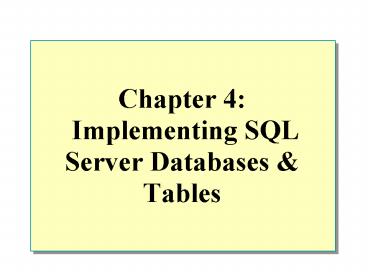Chapter 4: Implementing SQL Server Databases - PowerPoint PPT Presentation
1 / 26
Title:
Chapter 4: Implementing SQL Server Databases
Description:
Creator becomes the owner. Maximum of 32,767 per server. Follow naming rules. P144 ... Character and Unicode Character. Binary. Other. P155-159 ... – PowerPoint PPT presentation
Number of Views:86
Avg rating:3.0/5.0
Title: Chapter 4: Implementing SQL Server Databases
1
Chapter 4 Implementing SQL Server Databases
Tables
2
Overview
P143
- Creating and Managing a SQL Server Database
- Identifying Data Types
- Creating and Managing Tables
3
Creating and Managing a SQL Server Database
P144
- Factors to consider when creating databases
- Default Sysadmin, dbcreator
- Creator becomes the owner
- Maximum of 32,767 per server
- Follow naming rules
4
Create Database Statement
P145
- Creating a Database Defines
- The name of the database
- The size of the database
- The files where the database will reside
CREATE DATABASE SampleON PRIMARY (
NAMESampleData, FILENAME'c\Program
Files\..\..\Data\Sample.mdf', SIZE10MB,
MAXSIZE15MB, FILEGROWTH20) LOG ON (
NAMESampleLog, FILENAME 'c\Program
Files\..\..\Data\Sample.ldf', SIZE3MB,
MAXSIZE5MB, FILEGROWTH1MB)COLLATE
SQL_Latin1_General_Cp1_CI_AS
5
Setting Viewing Database Options
P146-149
- Set Database Options By Using
- SQL Server Enterprise Manager
- ALTER DATABASE statement
- Database Option Categories
- Auto options
- Cursor options
- Recovery options
- SQL options
- State options
6
Retrieving Database Information
P148
- Determine Database Properties by Using the
DATABASEPROPERTYEX Function - SELECT DATABASEPROPERTYEX (pubs,useraccess)
- SELECT DATABASEPROPERTYEX (pubs,recovery)
- Use System Stored Procedures to Display
Information About Databases and Database
Parameters - sp_helpdb
- sp_helpdb database_name
- sp_spaceused objname
7
Managing Databases
P148-150
- Managing Data and Log File Growth
- Monitoring and Expanding a Transaction Log
- Shrinking a Database or File
- Dropping a Database
8
Managing Data and Log File Growth
P148-150
- Using Automatic File Growth
- Expanding Database Files
- Adding Secondary Database Files
ALTER DATABASE Sample MODIFY FILE ( NAME
'SampleLog', SIZE 15MB) GO ALTER DATABASE
Sample ADD FILE (NAME SampleData2,
FILENAME'c\Program Files\..\..\
Data\Sample2.ndf', SIZE15MB,
MAXSIZE20MB) GO
9
Monitoring and Expanding a Transaction Log
P148-150
- Monitoring the Log
- Monitoring Situations That Produce Extensive Log
Activity - Mass loading of data into indexed table
- Large transactions
- Performing logged text or image operations
- Expanding the Log When Necessary
10
Shrinking a Database or File
P148-150
- Shrinking an Entire Database
- Shrinking a Data File in the Database
- Shrinking a Database Automatically
- Set autoshrink database option to true
DBCC SHRINKDATABASE (Sample, 25)
DBCC SHRINKFILE (Sample_Data, 10)
11
Dropping a Database
P150
- Methods of Dropping a Database
- SQL Server Enterprise Manager
- DROP DATABASE statement
- Restrictions on Dropping a Database
- While it is being restored
- When a user is connected to it
- When publishing as part of replication
- If it is a system database
DROP DATABASE Northwind, pubs
12
Identifying Data Types
P155
- System-supplied Data Types
- Creating and Dropping User-defined Data Types
- Guidelines for Specifying Data Types
13
System-supplied Data Types
P155-159
- Numeric
- Integer
- Exact numeric
- Approximate numeric
- Monetary
- Date and Time
- Character and Unicode Character
- Binary
- Other
14
Creating and Dropping User-defined Data Types
P160
Creating
Dropping
EXEC sp_droptype city
15
Creating and Managing Tables
P163-167
- Creating Tables in a SQL Server Database
- Determine Column Nullability
- Define Default Values
- Autonumbering and Identity Columns
16
Determine Column Nullability
P163-164
- In general avoid allowing Null values
- Make querying complex
- Cant be used to distinguish one row from another
- Not allowed in Primary Key constraint or IDENTITY
property - Consider using a Default instead
17
Generating Column Values
P163-167
- Using the Identity Property
- System generated sequential values
- Using the NEWID Function and the
uniqueidentifier Data Type
18
Using the Identity Property
P163-167
- Requirements for Using the Identity Property
- Only one identity column is allowed per table
- Use with integer, numeric, and decimal data types
- Retrieving Information About the Identity
Property - Use IDENT_SEED and IDENT_INCR for definition
information - Use _at__at_identity to determine most recent value
- Managing the Identity Property
19
Using the NEWID Function and the
uniqueidentifier Data Type
P168
- These Features Are Used Together
- Ensure Globally Unique Values
- Use with the DEFAULT Constraint
20
Methods for Creating a Table
P169
- Creating a Table
- Column Collation
- Specifying NULL or NOT NULL
- Computed Columns
- Dropping a Table
21
Modifying Tables in a SQL Server Database
P171
ALTER TABLE CategoriesNew ADD Commission money
null
ADD
Customer_name
Sales_amount
Sales_date
Customer ID
Commission
DROP
ALTER TABLE CategoriesNew DROP COLUMN
Sales_date
22
Generating Scripts
- Generate Schema as a Transact-SQL Script
- Maintain backup script
- Create or update a database development script
- Create a test or development environment
- Train new employees
- What to Generate
- Entire database into single script file
- Table-only schema
- Table and index schema
23
Recommended Practices
24
Review
- Creating and Managing a SQL Server Database
- Identifying Data Types
- Creating and Managing Tables
25
Lab Implementing SQL Server Databases Tables
26
Lab Implementing SQL Server Databases Tables
- Exercise 1
- Pages 150-154 Creating and Managing a Database
- Exercise 2
- Pages 160-162 Identifying Column Data Types
- Exercise 3
- Pages 172-174 Creating and Managing Tables in a
SQL Server Database

